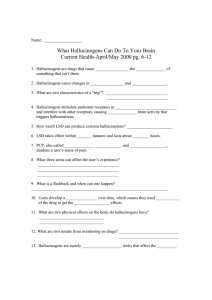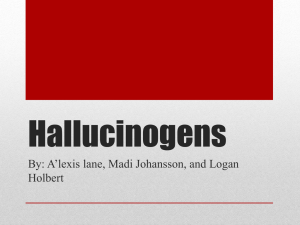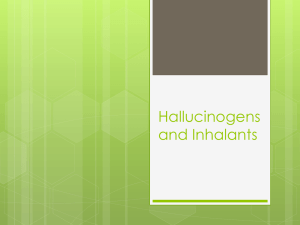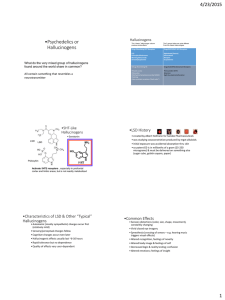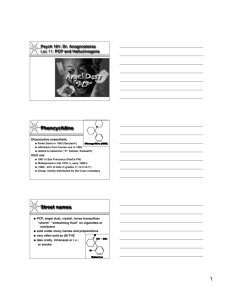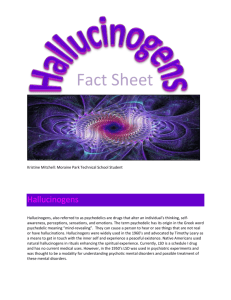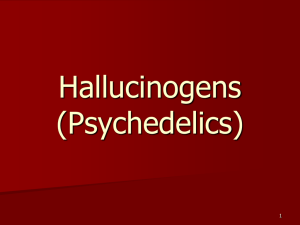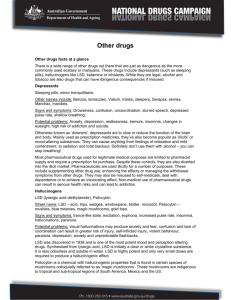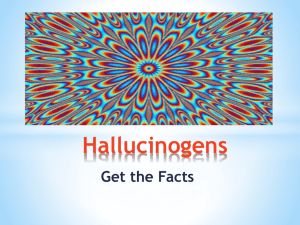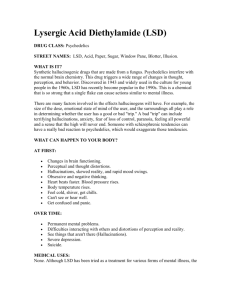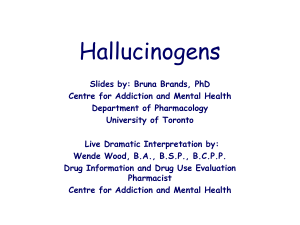Week 8
advertisement
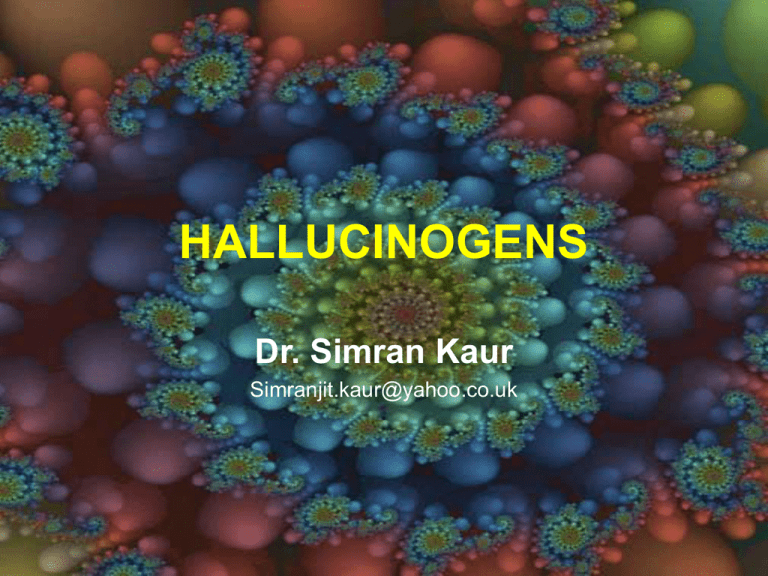
HALLUCINOGENS Dr. Simran Kaur Simranjit.kaur@yahoo.co.uk What? Substances which induce alterations in perception, cognitive function and feeling, producing gross impairment of memory. Cause people to see images, hear sounds and feel sensations which appear real but do not exist. Where? Most come from plants (plant alkaloids) Others are synthetic Traditionally used in shamanic rituals by Native American tribes Resemble ACh Catecholamines (NE and DA) Serotonin Have been used for thousands of years Used in religious ceremonies by cultures from the tropics to the arctic Used to induce states of detachment and produce ‘visions’ providing mystical insight Common effects: Alterations in time and space perception Minutes can be as slow as hours Reliving old events Changes in self-awareness Increased sensitivity to textures, shapes, tastes and sounds Person feels as if they are floating or being pulled by gravity Brighter colours, sharper sounds Colours can be heard or sounds seen Visual disturbances (i.e. flashes of light or kaleidoscope-like patterns) Hallucinations Feelings of enlightenment or spiritual awakening Physiological side-effects: Rapid heart rate Increased blood pressure Nausea and appetite loss Chills or flushing Shaking Paranoia Confusion Abnormal rapid breathing Acute panic (‘a bad trip’) Muscle spasms and loss of coordination Convulsions and unconsciousness Aggressive, hostile and violent behaviour Types 1. 2. 3. 4. Psychomimetics Psychedelics (mind-manifesting) – drugs that enhance or amplify thought processes. Dissociatives (a state of sensory deprivation)drugs which reduce or block signals from the senses to the ‘conscious mind’. Deliriants (anticholinergic hallucinogens) – drugs that produce clouding of consciousness and amnesia. Classification 1. Anticholinergic 3. Serotonin-like Scopolamine (Hyoscine) Mandrake Hyoscyamine Atropine Lysergic acid diethylamide (LSD) Dimethy-tryptamine (DMT) Psilocybin 2. Catecholamine-like Mescaline MDA (methylene-dioxyamphetamine) MDMA (methylene-dioxymethamphetamine – Ecstasy) Myristicin, Elemicin 4. Glutamatergic NMDA Receptor Antagonists Phencyclidine (PCP) Ketamine 5. Opioid Kappa receptor agonist Salvinorin A 1. Anticholinergic hallucinogens Scopolamine (hyoscine) Tropane alkaloid drug obtained from plants of the Solanaceae family Atropa belladonna (Nightshade) Datura stramonium (Thorn apple) Atropine Found in several members of the Solanaceae family. Most common sources are Atropa belladonna, Datura innoxia, D. metel and D. stramomium Anticholinergic hallucinogens Structurally similar to Acetylcholine and act by blocking muscarinic acetylcholine receptors (mAChRs) (Scopolamine structure on right above that of atropine) Pharmacological effects Dry mouth Tachycardia Pupil dilation Excessive dosage Tremor Fatigue and ataxia Marked palpitations Restlessness and excitement Hallucinations 2. Catecholamine-like hallucinogens Also called phenthylamine hallucinogens (partial stimulants, partial hallucinogens) a. Mescaline (3, 4, 5trimethoxyphenethylamine) Strucurally similar to catecholamine neurotransmitters NA (NE) and DA but with a methoxy OCH3 group attached to the phenolic ring Mescaline Norepinephrine Mescaline: Psychostimulant action Via DAergic stimulation in mesolimbic system Psychedelic action Via serotoninergic action at postsynaptic 5HT2A receptors Mescaline: Source From peyote cactus (SW USA and North Mexico) Hallucinogenic dose is about 0.3 – 0.5 g Effects last 10 – 12 hours Notable effects on visual system Hallucinations of bright lights, geometric designs, people and animals Not only drug of abuse but also sacramental drug Permitted for religious use in 23 US states (Literary ref: Aldous Huxley's The Doors of Perception, where Huxley writes of his experimentation with mescaline in Mexico). b. Amphetamine derivatives i. MDMA (3, 4methylenedioxymethampheta mine) ii. MDA (3, 4methylenedioxyamphetamine ) (a metabolite of MDMA) iii. MDE (3, 4methyllenedioxy-Nethylamphetamine) All are synthetic derivatives of amphetamines Also effects on emotional responses (i.e. nonhallucinogenic, non-stimulant effects) Entactogens: substances which enhance the ability to introspect and deal with disturbing or sorrowful feelings. Primary mechanism of action Stimulate DA release Enhance 5-HT release (cf amphetamine) Inhibition of 5-HT reuptake (cf amphetamine) Psychological effects Memory impairments and deficits in decisionmaking Loss of self-control Panic attacks on withdrawal Recurrent paranoia, depersonalization Depression Animal studies indicate serotoninergic neurotoxicity Source of picture: NIDA website From NIDA website: sections taken from the neocortex of monkeys that were given Ecstasy twice a day for 4 days (control monkeys were given saline). Peripheral effects Increased heart rate and blood pressure Hyperthermia Dehydration (sweating and salivation) – can be fatal for dancers Tremor Trismus and bruxism (tightening of jaw muscle and grinding of teeth) MDMA (from NIDA website) c. Myristicin and Elemicin Source: From Nutmeg and mace. Structurally similar to mescaline Onset of effects, within 2-5 hours and last up to 24-72 hours 5-15 g confusion, euphoria, hallucinations, nausea and vomiting, tremors Myristicin 3. Serotonin-like psychedelics Also called Indoleamine Hallucinogens A. Lysergic Acid Diethylamide (LSD) HISTORY: Albert Hofmann, Sandoz Pharmaceutical Company 1930s – to synthesize new cardiovascular and respiratory stimulants (Analeptics) from ergot alkaloids 1938 – Lysergic acid diethylamide synthesized 1943 – re-examine product and accidental ingestion hallucinogenic properties of the drug 1947 – launched as Delysid for psychotherapy 1970s – product banned and abandoned LSD A clear or white odourless water-soluble material Synthesized from lysergic acid, which is derived from a rye fungus. Strongest effects in cerebral cortex and locus ceruleus (area of the brain which receives sensory signals and has been called the brain’s ‘novelty sensor’). Most potent hallucinogen Therapeutic dose: 50 mg – 300 mg [14,000 mg (lethal dose x 280)] Available as Microdots (tablets) Window panes: LSD in gelatin Blotter acid: liquid added to paper Sugar cubes: LSD in sugarlumps Popularized by Timothy Leary in the 1960s Used the catchphrase ‘Turn on, Tune in and Drop Out’. Pharmacokinetics of LSD Onset: 0.5 – 1 hour Peak plasma levels: 3 hours Duration: 6 – 8 hours LSD blotters Physiological effects Mainly sympathomimetic Pupil dilation Increase in heart rate and blood pressure Slight hyperthermia Nausea and vomiting Psychological effects Alterations in perception, thinking, emotion and self-image Distortion of time Synaesthesia Hallucinations of lights, shapes, distorted images Mood swings May experience loss of boundaries, fear of fragmentation Long-lasting effects: Permanent reduction of information processing by neocortex Sensory overload Difficulty in coping and controlling emotional reactions Recurrence of psychological effects Flashbacks – brief, benign, pleasant Hallucinogen persisting perception disorder (HPPD) – long-term and distressing Tolerance to drug rapidly develops but is also rapidly lost (~ 1 week) No physical dependence in human or animals B. DMT (Dimethyltryptamine) Partial agonist at 5-HT2A and 5-HT2C receptors Metabolized rapidly by MAO Source: Found in several South American plants e.g. Mimosa hostilis DMT: Reaches full effect within 10 – 60 seconds of inhalation and last for < 30 minutes but effect is intense and similar to LSD effect. The Ayahuasca brews’ effect begin 20 – 60 minutes after ingestion and lasts about 3 – 4 hours. Ayahuasca Brew: Medicinal tea brewed from N, Ndimethyltryptamine (DMT) and harmala alkaloid-containing plants. The main harmala alkaloid components in Ayahuasca are: Harmine, harmaline and tetrahydroharmine (THH) Believed to possess highly active reversible MAO-A inhibiting properties DMT present is slowly degraded by MAO-A C. Bufotenine (dimethylserotonin) Source: Originally isolated from secretions of Bufo alvarius toad skin Can also be isolated from beans of the Anadenanthera colubrina, Anadenanthera peregrina trees. Similar effect to LSD and DMT Has also been found in urine in a proportion of: Violent offenders (those with paranoid personality traits have even higher urinary levels) People with autism Schizophrenic patients D. Psilocybin (4 – phosphoryl DMT) Active metabolite: Psilocin (4-hydroxy-DMT) Source: Present in many mushroom species Psilocybe cubensis and Psilocybe semilanceata (Liberty Caps) Similar effects to LSD and DMT Intoxication regarded as inducing a schizophrenia-like psychosis 4. Phencyclidine (PCP) and Ketamine Developed as i.v. anaesthetics but also discovered to be psychodelic PCP withdrawn from clinical use due to sideeffects Ketamine used mainly in veterinary anaesthesia (occasional human usage) Phencyclidine Ketamine PCP and Ketamine Non-competitive NMDA antagonists Induce toxic psychosis Repeated use induces chronic schizophrenic symptoms: Psychosis Hallucinations Delusions Thought disorder Social withdrawal In the Acute phase Induce intense analgesia and amnesia But subjects may appear to be awake though unresponsive PCP and Ketamine – only hallucinogens which induce addiction. 5. Salvinorin A The most potent naturally occurring non-nitrogenous drug (hallucinogen) Extracted from the plant Salvia divinorum (diviner’s sage, Mexican mint) Smoked (quick onset ~ 1 min, short-duration ~15 min) or eaten to induce intense hallucinations Radioligand binding assays involving 50 human cloned GPCRs, ion channels and transporters reviewed that The first described selective kappa opioid receptor agonist hallucinogen Does not activate 5-HT2A receptors (main molecular target responsible for classical hallucinogens) (Ref: Bryan et al., (2002) Salvinorin A: A potent naturally occurring non-nitrogenous kappa opioid selective agonist. Proc. Natl. Acad. Sci. 99: 11934-11939) REFERENCES MDMA Green (2003) Pharmacol Rev. 55: 463-508 Kalant (2001) CMAJ 165: 917-928 Serotonin and hallucinogens Aghajanian and Marek (1999) Neuropsychopharmacology. 21 (2 Suppl): 16S-23S Salvinorin A Chavkin et al. (2004) J. Pharmacol Exp. Ther. 308: 1197-1203
